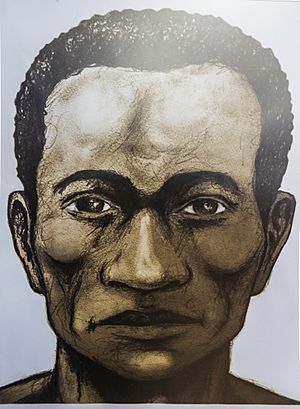Alonso de Illescas facts for kids
Quick facts for kids
Alonso de Illescas
|
|
|---|---|
 |
|
| Born | 1528 Portuguese Cape Verde
|
| Died | 1600 (aged 71–72) |
Alonso de Illescas lived from about 1528 to the 1600s. He was an African leader known as a Maroon. Maroons were enslaved people who escaped and created their own free communities. Alonso de Illescas was seen as the most powerful person in the Esmeraldas region of what is now northwestern Ecuador during the 1500s.
Contents
Early Life and Freedom
From Africa to Spain
Alonso de Illescas was born around 1528. He grew up off the coast of western Africa, possibly on the Cape Verde Islands or Tenerife. When he was about eight to ten years old, he was taken to Seville, Spain. There, he became a slave to a very rich merchant family called the Illescas.
During his time in Seville, he learned many things. He learned to speak Spanish, understood the local religion and culture, and even learned to play the vihuela (a Spanish guitar). He lived in Seville for seventeen years.
Journey to the Americas
After living in Spain, Alonso de Illescas was sent to the Caribbean. He first went to Santo Domingo, where his owners had a business. They sold many things, including clothing, food, and even enslaved Africans.
Unlike many enslaved people, Illescas likely never worked on a farm. Instead, he was a trusted personal helper for his owners. He traveled with them to Panama and then to Peru, which was a very important place for silver in the Spanish Empire.
In 1553, he was on a ship with other enslaved Africans heading to Peru. The ship ran into trouble near the coast of Esmeraldas in Ecuador. It got stuck, leaving everyone stranded on shore. During this difficult journey, Illescas and the other enslaved people saw a chance. They decided to escape into the thick forest and claim their freedom.
Life as a Maroon Leader
Building a New Community
Alonso de Illescas and the other escapees faced many challenges at first. They had to make alliances and sometimes fight with local native groups to survive. Another African named Antón was the first leader of their group. Later, Illescas became the leader of his Maroon community in the late 1560s.
Under his leadership, the community grew. It included not only Africans but also native people and even a few Europeans. For example, a priest named Alonso de Espinosa helped as a minister. Illescas's main helper was a Portuguese soldier named Gonzalo de Avila.
Power and Alliances
Like other Maroon communities, Illescas's group formed families with local native women. This helped them build political power and military strength in the region. The children of these families were often called zambos by the Spanish.
In the 1570s, Illescas's community also started trading with Spanish ships that visited the Esmeraldas coast. He had to show his strength against another group of Maroons called the Mangaches, who formed after another shipwreck. The area's thick forests and strong resistance from native groups helped the Maroon community stay free for many years.
Seeking Peace with Spain
Alonso de Illescas wanted to make peace with the Spanish authorities. He hoped they would officially recognize him and his community as free Africans. In 1563, a Spanish court called the Real Audiencia was formed in Quito. Spanish merchants wanted a port closer to Quito to trade more easily with Peru and Panama.
So, in 1577, the Real Audiencia suggested a big honor for Illescas. They proposed making him the governor of the region and giving him the noble title of "Don." This was very unusual for an African Maroon. In return, he was supposed to convince other local leaders and rival Maroon groups to settle near the Esmeraldas River. However, this attempt led to fighting among the different Maroon and native groups.
In 1586, Illescas sent a letter to the King of Spain and authorities in Quito and Madrid. He asked the King to cancel a plan that would allow a rich merchant to build settlements in Esmeraldas. Instead, Illescas offered to help make peace with his native neighbors himself. This showed how different groups were competing for control of the land and people. The Spanish authorities did not take his letter seriously at first. The merchant failed to gain Illescas's support and never built his settlements.
End of Life and Legacy
Passing the Leadership
Towards the end of his life, Alonso de Illescas ruled his community with the help of his two sons, Sebastián and Antonio. There are no records of him after the 1590s, so he likely died in the Esmeraldas region sometime between 1587 and 1596.
Even though Illescas did not live to see a peace agreement with the Spanish, it was eventually achieved. His son Sebastián received the title of Don and was recognized as the leader of the Illescas Maroons by 1600. Sebastián also took Alonso as his confirmation name. Illescas's family continued to lead the Esmeraldas region for at least two more generations.
A National Hero
In 1997, the National Congress of Ecuador officially made October 2nd the national day of Black Ecuadorians. This special day formally recognized Alonso de Illescas as a national hero.
See also
 In Spanish: Alonso de Illescas para niños
In Spanish: Alonso de Illescas para niños

